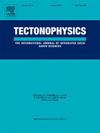地震活动导致西爪哇弧后逆冲的证据
IF 2.6
3区 地球科学
Q2 GEOCHEMISTRY & GEOPHYSICS
引用次数: 0
摘要
在这项研究中,设计了一个钻孔地震实验来研究与西爪哇弧后逆冲有关的地震活动。这个被动震源实验由七个钻孔地震仪组成,这些地震仪横跨苏邦地区和周边地区。该实验记录了2022年12月至2023年9月之间的地震数据,并辅以印度尼西亚气象、气候和地球物理局(BMKG)永久地震台网的数据。在临时阵列的记录期间,我们识别和定位了15次浅层地壳地震,并计算了它们的震源机制。这一时期弧后地区逆冲型地震的发生为西爪哇弧后逆冲构造活动的持续提供了证据。综合地质研究和前人研究成果,揭示了一个复杂的断层网络,包括Citarum前缘断层、Citarum断层和Baribis断层系统,表明区域应力场在水平和垂直方向上发生了显著变化。此外,我们确定了一个以前未被认识的断层,我们称之为Cirata断层,其特征是带有逆冲机制的地震。有趣的是,我们在Lembang断层的东端观察到正常的断层,这表明与古巽他火山口相关的旧断层结构的重新激活。这些发现对该地区的地震危害评估和备灾具有重要意义,并突出了地质学家、地震学家、城市规划者和决策者之间持续监测和合作努力的重要性。本文章由计算机程序翻译,如有差异,请以英文原文为准。

Evidence of the West Java back-arc thrust from earthquake activity
In this study, a borehole seismic experiment was designed to investigate seismic activity associated with the West Java back-arc thrust. This passive source experiment was composed of seven borehole seismometers that extended across the Subang region and surrounding areas. The experiment recorded seismic data between December 2022 and September 2023 and was supplemented by data from the Agency for Meteorology, Climatology, and Geophysics of Indonesia (BMKG) permanent seismic station network. During the recording period of the temporary array, we identified and located 15 shallow crustal earthquakes and computed their focal mechanisms. The occurrence of thrust-type earthquakes in the back-arc region during this period offers evidence of continued tectonic activity along the West Java back-arc thrust. Our integrated analysis, which incorporates geological studies and previous research, reveals a complex fault network comprising the Citarum Front Fault, Citarum Fault, and Baribis Fault system, indicating significant horizontal and vertical changes in the regional stress field. Furthermore, we identify a previously unrecognized fault, which we call the Cirata Fault, which is characterised by earthquakes with thrust mechanisms. Intriguingly, we observe normal faulting at the eastern end of the Lembang Fault, suggesting reactivation of old fault structures associated with the ancient Sunda Caldera. These findings have significant implications for seismic hazard assessment and disaster preparedness in the region, and highlights the importance of continuous monitoring and collaborative efforts among geologists, seismologists, urban planners, and policymakers.
求助全文
通过发布文献求助,成功后即可免费获取论文全文。
去求助
来源期刊

Tectonophysics
地学-地球化学与地球物理
CiteScore
4.90
自引率
6.90%
发文量
300
审稿时长
6 months
期刊介绍:
The prime focus of Tectonophysics will be high-impact original research and reviews in the fields of kinematics, structure, composition, and dynamics of the solid arth at all scales. Tectonophysics particularly encourages submission of papers based on the integration of a multitude of geophysical, geological, geochemical, geodynamic, and geotectonic methods
 求助内容:
求助内容: 应助结果提醒方式:
应助结果提醒方式:


